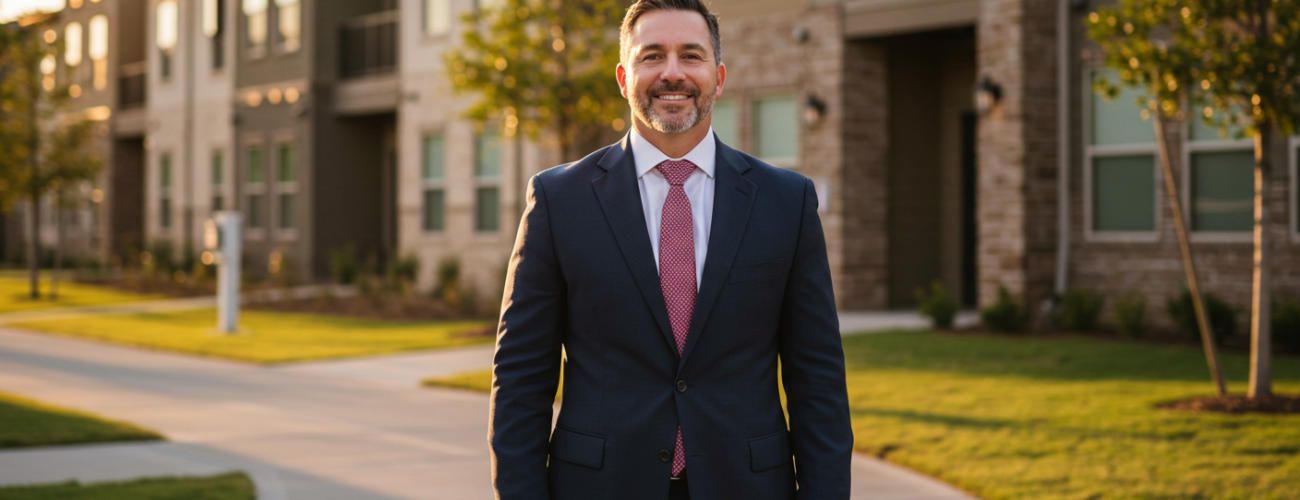- Introduction
- The Cost of Getting Apartment Insurance Wrong
- Why Apartment Building Insurance Is Different from Standard Property Policies
- The 5 Core Coverages Every Apartment Policy Should Include
- Valuation Pitfalls: How to Avoid Being Underinsured
- Deductibles and Wind/Hail Claims: What Most Owners Miss
- Common Exclusions That Catch Owners Off Guard
- What Carriers Look at When Pricing Apartment Risks
- How to Compare Quotes (Beyond Just Premium)
- The Renewal Process: How to Prepare for the Best Outcome
- How Trust Partners Helps Apartment Owners in North Texas

1. Introduction
If you own or manage an apartment community in Texas, you already know that insurance renewals can feel like a moving target. One year your premiums jump 25%. The next, your deductible doubles. Somewhere in between, you start to wonder if you’re even covered the way you think you are.
At Trust Partners Insurance, we review hundreds of apartment and HOA policies each year — and we’ve seen the same patterns repeat: outdated valuations, confusing exclusions, and missed opportunities to improve coverage without overspending.
This guide breaks down what every apartment property owner should know before renewal — so you can make confident, informed decisions that actually protect your investment.

2. The Cost of Getting Apartment Insurance Wrong
Insurance for apartment buildings isn’t something you notice until it’s too late. A small wording error or outdated value can mean the difference between a smooth claim and a six-figure out-of-pocket surprise.
In North Texas, we’ve seen hailstorms destroy roofs, frozen pipes burst across multiple units, and electrical fires shut down half a property — all in the same year. When those events happen, you don’t want to be guessing what’s covered.
Getting your renewal right isn’t about buying the cheapest policy. It’s about buying the right protection for the risk you actually carry.

3. Why Apartment Building Insurance Is Different from Standard Property Policies
Apartment building insurance looks a lot like regular commercial property coverage — until you read the fine print.
Unlike single-use buildings, apartments involve:
Multiple dwellings under one ownership, which increases exposure.
Tenant occupancy, meaning you’re insuring both the physical property and the public liability from dozens or hundreds of residents.
Shared systems and amenities — pools, gyms, clubhouses, elevators — each creating unique risk.
Standard property policies aren’t designed for that complexity. Apartment owners need multifamily-specific programs that address rental income, common areas, and liability for residents and guests alike.

4. The 5 Core Coverages Every Apartment Policy Should Include
Every apartment policy should start with a strong foundation of these five coverages:
🧱 1. Building / Property Coverage
Covers the physical structures — walls, roofs, foundations, and permanently installed fixtures. Make sure your policy uses replacement cost valuation, not “actual cash value,” to avoid depreciation losses.
⚖️ 2. General Liability
Protects you if a resident, vendor, or visitor is injured on the property. Even minor slip-and-fall incidents can turn costly fast.
💰 3. Loss of Rents / Business Income
If a fire or storm makes your property unlivable, this coverage replaces the lost rental income while repairs are made. Many owners overlook this — but it’s vital to cash flow survival.
⚙️ 4. Equipment Breakdown
Covers critical systems like boilers, HVAC units, elevators, and pumps — often excluded under standard property policies.
☂️ 5. Umbrella / Excess Liability
Provides additional layers of protection above your general liability and auto limits. With rising jury verdicts and inflation, this is no longer optional.
Pro Tip: Some carriers offer “Multifamily Enhancement Endorsements” that bundle valuable add-ons like water backup, outdoor property, and ordinance coverage.

5. Valuation Pitfalls: How to Avoid Being Underinsured
The most common (and expensive) renewal mistake we see? Outdated property valuations.
If your apartment building is insured for $6 million but would cost $9 million to rebuild today, you’re underinsured — and likely subject to coinsurance penalties at claim time.
Replacement costs should be reviewed every 2–3 years or whenever:
Construction or renovation occurs
Material or labor costs spike
Amenities are added (new clubhouse, playground, or pool)
Texas construction costs have climbed dramatically in the past few years. If you haven’t updated your insured value recently, you may be paying for “coverage” that won’t actually rebuild your property after a major loss.
Example: A property insured for $6M with an 80% coinsurance clause must carry at least $7.2M in coverage. Anything less could reduce the payout proportionally.

6. Deductibles and Wind/Hail Claims: What Most Owners Miss
In Texas, one of the biggest apartment exposures is wind and hail damage.
Most property owners don’t realize that wind/hail deductibles are often calculated as a percentage of the insured value, not a flat amount.
If your building is insured for $10 million and your deductible is 1%, you’re responsible for the first $100,000 of any wind or hail claim.
We often find owners with deductibles structured per building instead of per occurrence — a small wording difference that can multiply your out-of-pocket costs after a large storm.
Before renewal, review your deductible structure carefully. Ask your broker to model potential loss scenarios so you understand what’s really at stake.
7. Common Exclusions That Catch Owners Off Guard
Even the best apartment policy has exclusions — but some exclusions quietly strip away protection you think you have. The most common ones we uncover:
Ordinance or Law: Pays for the cost of bringing a damaged building up to current codes during repair. Without it, you may have to pay out of pocket for ADA or fire safety upgrades.
Water Backup and Sewer: Often excluded unless specifically added. One backed-up drain can flood multiple units.
Vacancy Clauses: Coverage can be reduced or denied if units sit vacant beyond a certain time.
Property Off-Premises: Construction materials or equipment stored elsewhere might not be covered.
These are simple to fix — but only if you know they exist. That’s where a specialized review makes the difference.

8. What Carriers Look at When Pricing Apartment Risks
Insurance pricing isn’t random — underwriters evaluate risk factors that predict future losses. Understanding these helps you position your property for better rates.
Carriers assess:
Year Built / Age of Roofs – The newer or recently updated, the better.
Electrical, Plumbing, HVAC Updates – Reduces fire and water damage risks.
Tenant Mix & Occupancy – Long-term tenants often mean fewer claims than short-term or subsidized housing.
Loss History – Frequent claims increase premiums or cause non-renewal.
Security Features – Gates, surveillance, and sprinklers can all earn credits.
Documenting upgrades and safety improvements — even small ones — can help your agent negotiate better pricing.
9. How to Compare Quotes (Beyond Just Premium)
Price matters — but not as much as what you’re getting for it.
When comparing quotes, look beyond the bottom line. Evaluate:
Coverage limits and valuation basis (replacement cost vs. ACV)
Deductible structure (flat vs. percentage-based)
Included extensions (water backup, ordinance, outdoor property, etc.)
Carrier quality (A.M. Best rating, claims handling reputation)
Agent accessibility and response time
We often show clients two scenarios:
Cheaper Policy: $3,000 less premium, $100,000 higher deductible, and no ordinance coverage.
Optimized Policy: Slightly higher premium, but $250,000 better claim recovery.
Once you see it laid out, “cheap” rarely looks cheaper.

10. The Renewal Process: How to Prepare for the Best Outcome
Great renewals don’t happen by accident — they happen through preparation.
Start the process at least 90 days before renewal. Here’s what to have ready:
Updated property schedule (building values, addresses, occupancy)
Recent loss runs from your current carrier
Documentation of upgrades or maintenance improvements
Rent roll and operating income
Vendor COIs (for landscaping, pool, janitorial, etc.)
At Trust Partners Insurance, our process is simple but effective:
Assess your current program for gaps and inefficiencies.
Align your risk profile with the right markets and carrier appetite.
Protect your property with a policy that’s fair, clear, and proactive.
The earlier you start, the more leverage we have to negotiate and shop carriers effectively.
11. How Trust Partners Helps Apartment Owners in North Texas
For more than a decade, we’ve helped apartment owners, condo associations, and property managers across DFW navigate a difficult insurance market.
We know the carriers that specialize in multifamily risk — and which ones don’t. We know how to explain your property in a way that gets underwriters excited instead of cautious. And we know that sometimes, the best “insurance” is a clear plan and a responsive partner when things go wrong.
If your renewal is approaching, don’t go it alone.
Let’s make sure your coverage actually fits your community — not just your last renewal.
